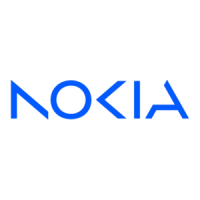Boot Options
130
7210 SAS-M, T, R6, R12, Mxp, Sx, S Basic System
Configuration Guide
3HE 16132 AAAB TQZZA Edition: 01
After the uplinks are connected and the node is powered up, the satellite node sends
out DHCP packets. The host matches the MAC address in the DHCP packet against
the host configuration to identify the satellite and provides the correct BOF to the
satellite node for booting up. The BOF sets the host-type command to satellites and
also provides the location of the TiMOS (SR OS) image and configuration file. The
boot loader fetches the TiMOS image and configuration file and boots up in satellite
mode.
4.1.4.5 System Boot Options for 7210 SAS-Mxp, 7210 SAS-S 1/
10GE, 7210 SAS-Sx 1/10GE, and 7210 SAS-Sx 10/100GE in
Standalone Mode
When operating in standalone mode, these 7210 SAS platforms support the
following options to boot the system:
• internal flash (cf1:\)
• external SD card slot (cf2:\)
• external USB flash (uf1:\) (not available for 7210 SAS-S 1/10GE)
• network (with auto-init; auto-init is not supported on platforms operating in
standalone-VC mode)
• network (without auto-init)
Because multiple storage locations are available for the boot loader (boot.tim) on the
7210 SAS-Sx 1/10GE, 7210 SAS-S 1/10GE, and 7210 SAS-Sx 10/100GE, these
platforms do not support the golden bootstrap image.
During bootup, the bootrom searches for the boot.tim in the following locations in the
specified order and uses the image obtained from the first location where boot.tim is
found to load the bootstrap image:
• cf1:\ (internal USB)
Note: When operating the 7210 SAS platform in satellite mode, Nokia recommends to use
only the auto-init procedure to retrieve the BOF and other boot parameters from the host.
Other procedures, such as the manual configuration of the BOF, are not allowed. See Auto-
init Mode for more information.
Note: See the Virtual Chassis chapter for information about boot up and configuration of the
7210 SAS-Sx/S 1/10GE operating in standalone-VC mode.

